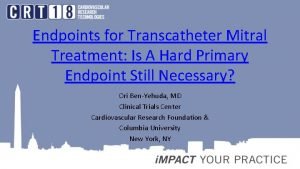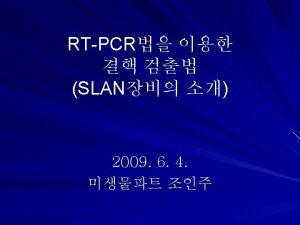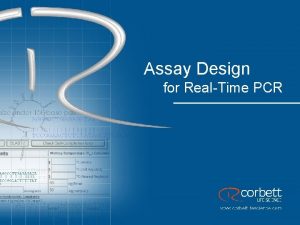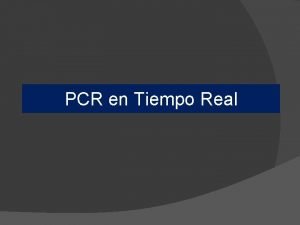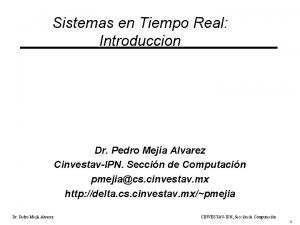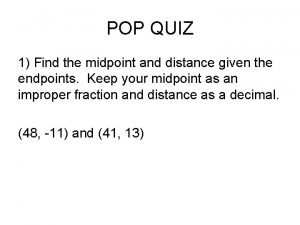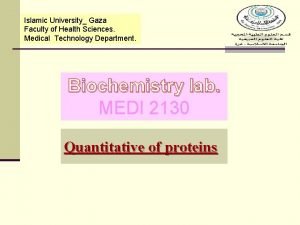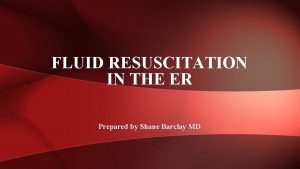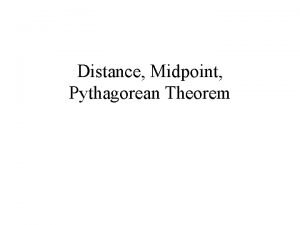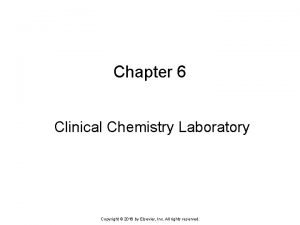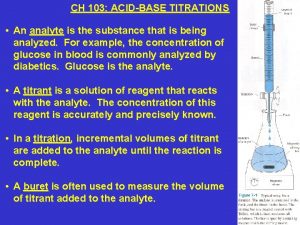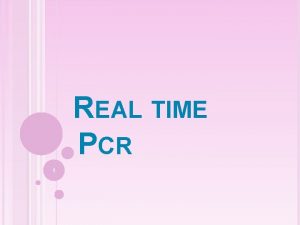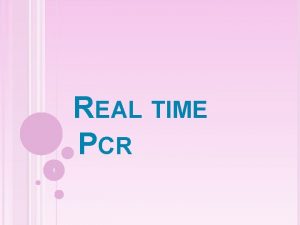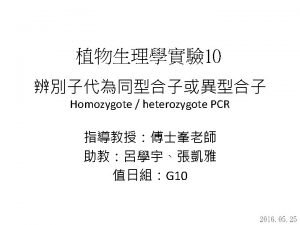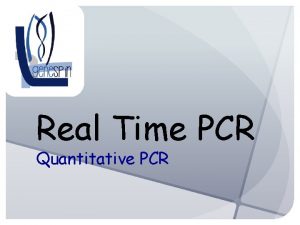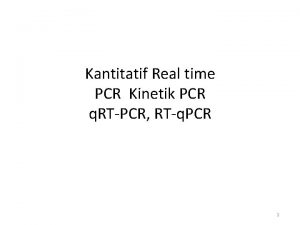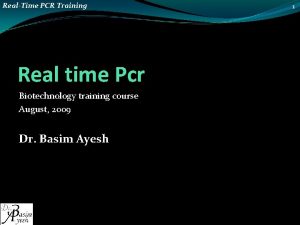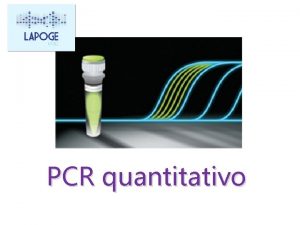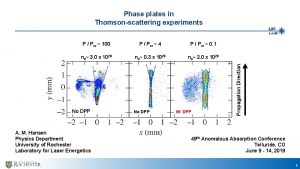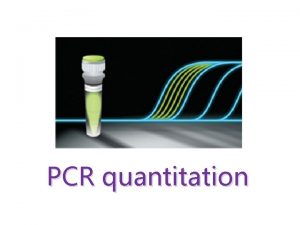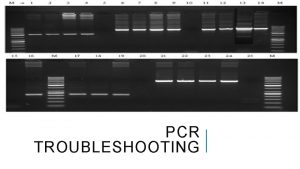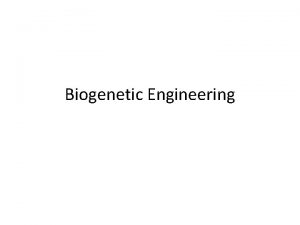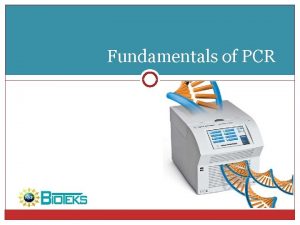REAL TIME PCR 1 LIMITATIONS OF ENDPOINT PCR

















- Slides: 17

REAL TIME PCR 1

LIMITATIONS OF END-POINT PCR • • Poor Precision Low sensitivity Low resolution Non - Automated Size-based discrimination only Results are not expressed as numbers Ethidium bromide for staining is not very quantitative Post PCR processing 2

THE EVOLUTION OF PCR TO REAL-TIME Traditional PCRs use Agarose gels for detection of amplification at the final phase or end-point of the PCR reaction Real time PCR has advanced to allow detection before the end-point of the reaction. 3

REAL-TIME PCR DETECTION While the reaction is occurring �monitors the fluorescence emitted during the reaction as an indicator of amplicon production at each PCR cycle Real-Time chemistries allow for the detection of PCR amplification during the early phases of the reaction 4

5

• Exponential: • • Exact doubling of product is accumulating at every cycle (assuming 100% reaction efficiency). The reaction is very specific and precise. Linear (High Variability): • • PCR PHASES The reaction components are being consumed, the reaction is slowing, and products are starting to degrade. Plateau (End-Point: Gel detection for traditional methods): • The reaction has stopped, no more products are being made and if left long enough, the PCR products will begin to degrade. 6

7

The plateau effect on a fivefold dilution series: �The 5 -fold dilution series, seems to plateau at the same place even though the exponential phase clearly shows a difference between the points along the dilution series. This reinforces the fact that if measurements were taken at the plateau phase, the data would not truly represent the initial amounts of starting target material. 8

REAL-TIME PRINCIPLES Three general methods for the quantitative detection: 1. Hydrolysis probes (Taq. Man). 2. DNA-binding agents (SYBR Green). 9

TAQMAN CHEMISTRY Real-time systems using fluorogenic-labeled probes that use the 5´ nuclease activity of Taq DNA polymerase. � Detecting only specific amplification products. � Eliminate post-PCR processing for the analysis of probe degradation 10

�A fluorogenic probe enables the detection of a specific PCR product as it accumulates during PCR. � � � The Taq. Man® Probe is designed with a high-energy dye termed a Reporter at the 5 end, and a low-energy molecule termed a Quencher at the 3 end. While the probe is intact, the proximity of the quencher dye greatly reduces the fluorescence emitted by the reporter dye by fluorescence resonance energy transfer (FRET) through space. When reporter and quencher are separated the reporter fluoroscence 11

HOW TAQMAN SEQUENCE DETECTION CHEMISTRY WORKS 1. 2. If the target sequence is present, the probe anneals downstream from one of the primer sites During extension the probe is cleaved by the 5´ nuclease activity of Taq DNA polymerase. � � 3. The reporter dye is separated from the quencher dye, increasing the reporter dye signal. The probe is removed from the target strand, allowing primer extension to continue to the end of the template strand. . Additional reporter dye molecules are cleaved from their respective probes with each cycle. 12

• The fluorescence intensity is increased proportional to the amount of amplicon produced. 13

SYBR® GREEN I DYE CHEMISTRY Small molecules that bind to doublestranded DNA can be divided into two classes: �Intercalators �Minor-groove binders There are two requirements for a DNA binding dye for real-time detection of PCR: � Increased fluorescence when bound to double-stranded DNA � No inhibition of PCR 14

HOW THE SYBR GREEN I DYE CHEMISTRY WORKS When SYBR Green I dye is added to a sample, it immediately binds to all double-stranded DNA present in the sample. ● During the PCR, the DNA Polymerase amplifies the target sequence, and creates the PCR products. ● The SYBR Green I dye binds to each new copy of double-stranded DNA. ● As the PCR progresses, more amplicons are created. The result is an increase in fluorescence intensity proportionate to the amount of PCR product produced. 15

� Advantages of SYBR Green I Dye � It can be used to monitor the amplification of any double -stranded DNA sequence. � No probe is required, which reduces assay setup and running costs. � Disadvantage of SYBR Green I Dye � SYBR Green I dye chemistry may generate false positive signals � SYBR Green I dye binds to nonspecific double-stranded DNA sequences. � Needs fully optimized PCR system -no primer dimers or non-specific amplicons. When not to choose SYBR Green Multiplex reactions. 16

REAL-TIME PCR ADVANTAGES � Not influenced by non-specific amplification � Amplification can be monitored in real-time � No post-PCR processing of products (high throughput, low contamination risk) � Ultra-rapid cycling (30 minutes to 2 hours) � Most specific, sensitive and reproducible � Not much more expensive than conventional PCR (except 17 equipment cost)
 How to find missing endpoint with midpoint
How to find missing endpoint with midpoint Hard endpoint vs soft endpoint
Hard endpoint vs soft endpoint Slan real time pcr
Slan real time pcr Gapdh size
Gapdh size Pcr tiempo real y punto final
Pcr tiempo real y punto final Sensor and (tiempo real or real time)
Sensor and (tiempo real or real time) 117 rest rules
117 rest rules What is elapsed time
What is elapsed time Sequence diagram endpoint
Sequence diagram endpoint Quiz 1-2 distance and midpoint partitioning a segment
Quiz 1-2 distance and midpoint partitioning a segment Difference between endpoint and kinetic method
Difference between endpoint and kinetic method Tivoli endpoint
Tivoli endpoint Endpoint of resuscitation
Endpoint of resuscitation Midpoint formula examples
Midpoint formula examples How do you find the midpoint
How do you find the midpoint Endpoint formula
Endpoint formula Serum osmolality formula
Serum osmolality formula Indicator end point
Indicator end point

